Kids and Dogs
Kids and dogs! Ah! These words can describe the very best of childhood or exemplify the worst!
Unfortunately, dogs are not very well understood in our culture and plenty of myths abound to cloud our perceptions. This applies to children and adults alike. Dogs are looked upon as children’s “playmates”, treated like stuffed toys, just as adult dogs are routinely referred to as “puppies” by parents.
There is a lot to learn about dogs! You might be reading Kids & Dogs because you are planning on adding a pup or dog to your family or because you have already encountered some challenges. I hope you’ll find interesting ideas and educational resources that will help you to become more informed and will lead you to greater success when dealing with dogs in the company of children. There are definitely rules for success, many of which you can find below.
THANK YOU for making dogs a safe and wonderful part of childhood!
Safety First!
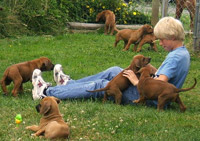 Bite statistics tell us that almost one in two children is bitten before they reach adolescence. Most of these bites are from dogs known to the child (either the family dog or friend’s or relative’s dog). Educating the general public, all dog owners, and all parents and children about bite prevention is an answer to solving this problem. It is easy for someone like you to become better informed and to address the issue of safety around dogs! The Canadian non-profit organization Doggonesafe provides fabulous information and several programs for free at
http://www.doggonesafe.com/.
Bite statistics tell us that almost one in two children is bitten before they reach adolescence. Most of these bites are from dogs known to the child (either the family dog or friend’s or relative’s dog). Educating the general public, all dog owners, and all parents and children about bite prevention is an answer to solving this problem. It is easy for someone like you to become better informed and to address the issue of safety around dogs! The Canadian non-profit organization Doggonesafe provides fabulous information and several programs for free at
http://www.doggonesafe.com/.
Book a ‘Be a Tree’ presentation for your child’s classroom now by contacting me domena@definitelydogs.ca
Prevention
Accidents can be prevented and children can learn appropriate and safe behaviour around dogs, just as dogs need to be trained to behave appropriately around children! However, certain basic principles must be employed:
- Supervise all interactions between dogs and your children
- Familiarize yourself with a dog’s body language signals that show signs of stress or unease
- Teach these easily recognized signals to the children in your life
- Help your dog out of stressful situations before he takes matters into his own 'teeth’
If children are visiting your household consider whether your dog would be better off in safe separation with a favorite chew. Many dogs are just not comfortable with children. Learn more about some of the unfortunate misunderstandings between children and dogs below Supervision, Supervision, Supervision!
Meeting a Dog
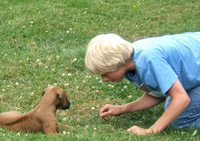 Children as well as adults quickly feel familiar with dogs they meet, but forget that such dogs are strangers whose language we likely do not understand or speak. Please, visit
http://www.doggonesafe.com/ for guidance on safety around dogs and learn about great bite prevention strategies!
Children as well as adults quickly feel familiar with dogs they meet, but forget that such dogs are strangers whose language we likely do not understand or speak. Please, visit
http://www.doggonesafe.com/ for guidance on safety around dogs and learn about great bite prevention strategies!
Your Very Own Family Dog
Although it might only take a second to fall in love with a dog, great family dogs are not created overnight. It takes several different ingredients and hard work to raise a really great dog.
Please, browse through the section below in which I have listed ten rules for success:
- Time to Get a Dog?
- Who Will Be The Real Owner?
- Selecting the Right Dog
- Supervision, Supervision, Supervision!
- Reward-based Training
- The Magic of Management
- Enlisting Your Child
- Catching Things Early
- Training Activities For Children
- Before Bringing Home Baby
• Time to Get a Dog?
When considering getting a dog think of it as adopting another child (an adult dog as a teenager, a puppy as a new baby). Are you ready to take on the extra burden of care for another dependent household member? Do you have sufficient time available to take care of a very different set of needs, including house breaking, training for polite behaviours and obedience, play and exercise, and other successful social interactions?
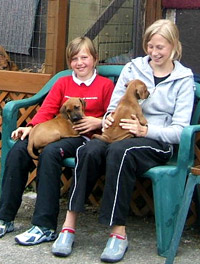 How old are your children now and how old will they be when the dog is mature? Children from seven years of age and up are more successful in helping with a dog, but will still need your continued supervision and guidance in all dog-related activities. Children under seven pose more specialized demands, since they are too young to self-inhibit. This requires you to teach both dog and child on the most profound levels about all daily interactions. Nevertheless, children as young as four or five can successfully participate in various dog-related activities (please, see below for several ideas)
How old are your children now and how old will they be when the dog is mature? Children from seven years of age and up are more successful in helping with a dog, but will still need your continued supervision and guidance in all dog-related activities. Children under seven pose more specialized demands, since they are too young to self-inhibit. This requires you to teach both dog and child on the most profound levels about all daily interactions. Nevertheless, children as young as four or five can successfully participate in various dog-related activities (please, see below for several ideas)
• Who Will Be the Real Owner?
It is the greatest wish of many children to own a dog; however, the ultimate responsibility for the well- being of the animal always lies with the parent!
A ‘golden rule’ for children as owners is: Once the child is old enough to take care of his or her own needs s/he can begin to responsibly take care of another being. Still, the process requires much learning and parental supervision. Compared to other common pets, dogs pose more complex and time consuming care demands.
• Selecting the Right Dog
When choosing a dog there are at least three basic elements to consider: Life stage (puppy vs. adult), breed and temperament/personality.
A puppy of suitable breed, temperament and personality can develop into a fabulous family dog with lots of patience, skill and time. While young puppies (between 7-12 weeks of age) are most adaptable they also offer the greatest challenges in management and training as they are “babies” themselves. However, pups of incompatible temperament, personality or breed can present insurmountable difficulties!
The advantage of an adult dog is that mostly ‘what you see is what you get’. Desirable traits such as a preference for children, calmness, great tolerance to noise and commotion are obvious and can be tested for. The book Successful Dog Adoption by Sue Sternberg offers great guidance for selecting an adult dog.
Breed characteristics have an immense influence on the behaviour of dogs and are hugely underrated! For example, consider whether you would rather have your children herded, guarded or retrieved for?
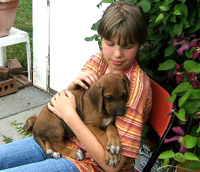 Please, familiarize yourself thoroughly with the characteristics of different breeds before choosing a dog! Skip sources essentially written as advertisement (Canadian Kennel Club, American Kennel Club or many breeders’ info) and go to independent sources that either compare several breeds (look for recommended books under Resources) or inquire with breed rescues for the more challenging aspects of a breed. Also, be aware of different breed lines and that there are huge differences between individual pups in the same litter. (Do not take the pup that chooses you, but select a stable, non-reactive, calm and outgoing, yet submissive pup.)
Please, familiarize yourself thoroughly with the characteristics of different breeds before choosing a dog! Skip sources essentially written as advertisement (Canadian Kennel Club, American Kennel Club or many breeders’ info) and go to independent sources that either compare several breeds (look for recommended books under Resources) or inquire with breed rescues for the more challenging aspects of a breed. Also, be aware of different breed lines and that there are huge differences between individual pups in the same litter. (Do not take the pup that chooses you, but select a stable, non-reactive, calm and outgoing, yet submissive pup.)
D. Tortora’s book The right dog for you ranks 123 breeds according to their sociability with children and contains a list of exceptionally suited breeds. Please, start out with a breed that prefers children instead of merely ‘tolerating’ them!
• Supervision, Supervision, Supervision!
All interactions between children and dogs need to be supervised! Please, remember that both child and dog need to learn appropriate and considerate behaviour with each other, and that you are the teacher of both.
Some common play behaviours of younger children are often entirely misinterpreted by dogs. Erratic movements such as running, flapping arms, jumping , falling down, playing on all fours or on the floor, or squealing can startle dogs or bring out predatory behaviour.
Even well-meant hugs, kisses and dress-ups; restraints; force or punishment; scolding or pulling on ears, tails, hair; poking etc. can elicit warning behaviours such as growling or snapping or ‘disciplinary’ bites from dogs. Teasing, staring, wrestling, hitting with hands or objects or otherwise encouraging aggressiveness builds frustration in dogs and can eventually lead to viciousness. Please, save you child and save your dog by always supervising!
• Reward-Based Training
Dogs learn ‘24/7’, either what we teach them intentionally or inadvertently as they will train themselves! An active, reward-based approach of teaching desirable behaviours works extremely well. First, decide which behaviours are desirable in what situations. Train in the absence of distractions until your dog can easily comply. Gradually, introduce more distractions, such as your children, and continue training to the point where your dog automatically shows the correct behaviour.
Most people greatly benefit from the help of a skilled professional in the early stages, unless you are well versed in basic dog training techniques such as luring or shaping. Click here to find a professional in your area or contact me for help locally domena@definitelydogs.ca. When you cannot actively train and your dog is not trained enough to behave well in a particular situation, manage your dog for immediate success!
• The Magic of Management
After supervision and training, management is the third indispensable tool to guarantee good relations between kids and dogs! Management solves everything right away, while all efforts with training take time to take effect. Management sets everybody up to succeed and allows you to take some time off! There are many fabulous management methods including happy time-outs for both, dogs and kids.
Most management techniques are easily applied. Once the principles are accepted, daily application means success for dog and family. For help and more detailed ideas contact me domena@definitelydogs.ca or another skilled dog professional in your area.
• Enlisting a Child’s Cooperation
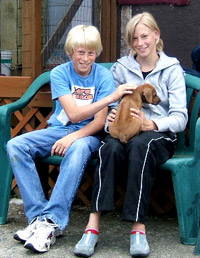 Setting things up for success by employing management strategies, keeping tempers cool, and approaching child/dog time as training time will help prepare the stage. This allows you to enlist the child as a helper in guided activities. Positive reinforcement works for both, dogs and children! Take time to praise your child for doing the ‘right’ thing, even if it only lasts a second.
Setting things up for success by employing management strategies, keeping tempers cool, and approaching child/dog time as training time will help prepare the stage. This allows you to enlist the child as a helper in guided activities. Positive reinforcement works for both, dogs and children! Take time to praise your child for doing the ‘right’ thing, even if it only lasts a second.
There are many activities that even fairly young children can engage in to help care for or train a dog: Measuring and dishing out kibble, baking food treats, helping with a simple dog related sewing project, clicking or presenting treats as part of clicker training, playing safe games (please, see more ideas yet under
Training Activities for Children)
Games promoting good relations: - Good games stress cooperation and teach child and dog to
coexist peacefully -
|
Games promoting risks: - Risky games pitch dog and child into competitive roles;
children can never win in such situations and the dog experiences
his physical superiority -
|
(For other child-typical but unsafe behaviours which further or contribute to problem
behaviour in dogs, please, read under Supervision, Supervision, Supervision!)
• Catching Things Early; Redirecting
Modern households with children are often extremely busy. Interactions and challenges for the supervising adults become more complex once a dog is added to the mix. Although spare time might be hard to come by, it greatly helps to take time to reflect:
- Are things going in the right direction?
- What great behaviours went unnoticed in the dog or the child?
- How can they be rewarded next time?
- What were some challenging moments and how could they be prevented or better solved?
- When would more management help?
Please, do not hesitate to involve a skilled professional at this time! Contact me for help on mid-Vancouver Island domena@definitelydogs.ca or go to www.cappdt.ca to find somebody in your area.
• Training Activities for Children
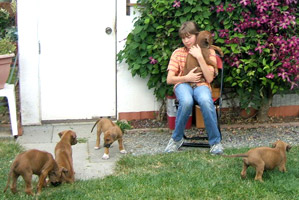 Most children love to help train a dog. Allowing your child to participate in the training process will encourage a sense of responsibility and develop a good relationship between the child and dog. There are many ways in which children of different ages can participate in non-coercive, reward-based training such as Clicker training! Even children as young as four or five years can participate by either dispensing a treat after the click (easier) or clicking for specified behaviours (harder). Most children excel in simple training tasks! Slightly older children can work more independently on obedience or trick training, or learn about dog sports such as junior show handling or agility. For more ideas on any of the above, call your local dog-training club; buy
Clicker Puppy, a CD featuring children teaching young puppies from
www.doggonecrazy.ca or contact
me domena@definitelydogs.ca
Most children love to help train a dog. Allowing your child to participate in the training process will encourage a sense of responsibility and develop a good relationship between the child and dog. There are many ways in which children of different ages can participate in non-coercive, reward-based training such as Clicker training! Even children as young as four or five years can participate by either dispensing a treat after the click (easier) or clicking for specified behaviours (harder). Most children excel in simple training tasks! Slightly older children can work more independently on obedience or trick training, or learn about dog sports such as junior show handling or agility. For more ideas on any of the above, call your local dog-training club; buy
Clicker Puppy, a CD featuring children teaching young puppies from
www.doggonecrazy.ca or contact
me domena@definitelydogs.ca
• Before Bringing Home Baby
Long before you bring home your new infant, begin to lay the foundation for your dog to accept the impending changes in your household. This might include changes to rules or access, reducing time and quality of attention, new baby sounds and smells… Go to
http://www.doggonesafe.com/ for many ideas or to enroll in their Doggone Smart with Your New Baby program, or visit
http://www.dogsandstorks.com and consider their fabulous program.
Back to top of page